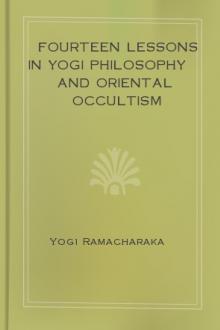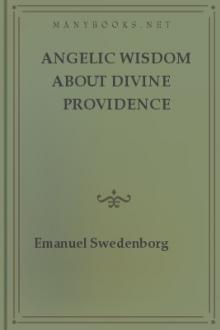A Series of Lessons in Gnani Yoga by William Walker Atkinson (best ereader for pc .txt) 📕

- Author: William Walker Atkinson
- Performer: 1428013288
Book online «A Series of Lessons in Gnani Yoga by William Walker Atkinson (best ereader for pc .txt) 📕». Author William Walker Atkinson
Oh, dear students, be not deceived by the mask of Personality which you may happen to be wearing at this moment, or by the masks which are worn by those around you. Realize that back of your mask is the great Individual—the Indivisible—the Universal Life, in which you are a centre of consciousness and activity. This does not wipe out your identity—instead it gives you a greater and grander identity. Instead of your sinking into a Nirvana of extinction of consciousness, your consciousness so enlarges as you unfold, that you will in the end feel your identity to be the identity of the Universe. Instead of your gaining Nothingness, you gain Allness. All spiritual growth and unfoldment gives you a constantly increasing sense of relationship with, and agreement with, the All. You grow into Allness as you unfold. Be not deceived by this chatter about Nothingness, and loss of Individuality, in the Oriental thought, although some of the presentations of its teachings may so seem to mean at first reading. Remember always that Personality is the mask, and Individuality the Real One.
You have often heard persons, claiming to be acquainted with the teachings of Theosophy and other expositions of the Oriental Wisdom Religion (including our own presentation), asserting that the Oriental mind was ever bent upon attaining a final stage of Nothingness or Extinction in Nirvana. In addition to what we have said, and to what we shall say on this subject, let us quote from the inspired writer of the "Secret Doctrine" (a standard Theosophical work) when she says, in that work on page 286, Vol. I: "Is this annihilation, as some think? … To see in Nirvana annihilation, amounts to saying of a man plunged in a sound, dreamless sleep—one that leaves no impression on the physical memory and brain, because the sleeper's Higher Self is in its original state of absolute consciousness during these hours—that he too is annihilated. The latter simile answers only to one side of the question—the most material; since reabsorption is by no means such a dreamless sleep, but, on the contrary, absolute existence, an unconditional unity, or a state, to describe which human language is absolutely and hopelessly inadequate… Nor is the individuality—nor even the essence of the personality, if any be left behind—lost because re-absorbed." As J. Wm. Lloyd says, in connection with the above quotation, "This seems conclusive proof that Theosophy does not regard Nirvana as annihilation, but as an infinite enlargement of consciousness." And we would add that this is true not only as regards the Nirvana of the Theosophist, but also of the consciousness of the Unity of Life—the Universal Life. This too is not annihilation of individual consciousness, but an "infinite enlargement of consciousness" as this Western writer Lloyd has so well expressed it.
The very consciousness of Life that every man feels within him, comes not from something belonging exclusively to himself as a separate or personal thing. On the contrary, it belongs to his Individuality, not to his Personality, and is a phase of his consciousness or "awareness" of his relation to the One Universal Life which underlies his existence, and in which he is a center of consciousness. Do you grasp this idea? If not, meditate and concentrate upon it, for it is important. You must learn to feel the Life within you, and to know that it is the Life of the great Ocean of Universal Life upon the bosom of which you are borne as a centre of consciousness and energy. In this thought there is Power, Strength, Calm, Peace, and Wisdom. Acquire it, if you are wise. It is indeed a Gift from the Gods.
In this lesson we are not attempting to build up your idea of the Unity of Life by a series of arguments taken from a world of phenomena in which separateness and non-Unity is apparent. No such arguments would suffice, for it would be like trying to prove the existence and laws of color to a man born blind, by arguments taken from his world of darkness. On the contrary we are appealing to that region of the mind in which is stored the capacity for intuitively apprehending truth. We are endeavoring to speak in tones which will awaken a similar vibration in that part of your mentality, and if these vibrations be started into being, then will you be able to feel and know the truth, and then will your Intellect eagerly seize upon the new idea that it finds within itself, and will proceed to apply the same to the various problems that have been bothering you in the past.
This consciousness of Unity must come from the higher regions of the mind, for the Intellect alone knows it not,—it is out of its field. Just as one may not know that the earth is round by means of his senses which report quite the contrary, but may and does know this truth by abstract reasoning and higher intellectual effort; so may one know the truth that All Life is indeed One, at the last, and underlying, by the higher faculties of the mind, although his senses and ordinary intellectual processes fail to so inform him. The senses cannot inform man that the earth is round, because they cannot see it as a whole, but only in part—while the higher reasoning faculties are able to visualize the earth as a whole, and know it must be round. And the Intellect, in its ordinary field can see only separateness, and cannot report Oneness, but the Higher Mind sees Life as a Whole, and knows it to be One. And it is the Higher Mind that we are trying to bring into the field of consciousness in the appeal to you in this lesson. We trust that we may be successful—in fact we know that we shall be so, in many cases, for we know that the field is ready for the sowing of the seed—and that the call has been heard, and the message passed on to us to answer the call—else these words would not have been written.
The consciousness of the Unity of Life is something that must be experienced before the truth may be realized. It is not necessary for one to wait until he acquire full Cosmic Consciousness before he may realize, at least partially, the Oneness of All Life, for he may unfold gradually into the Cosmic Knowing, experiencing at each stage a fuller conception of the underlying Unity of Life, in which he is a centre of consciousness and manifestation. But there must be at least a partial unfoldment before one is able to feel the sense of Unity. To those who have not unfolded sufficiently to gain at least a glimmering of the truth, everything appears separate from every other thing, and there is no Unity of All. It is as if every leaf on a mighty tree were to consider itself a being separate and distinct from everything else in the world, failing to perceive its connection with the branch or limb, and tree, and its unity in being with every other leaf on the tree. After a bit the unfolding consciousness of the leaf enables it to perceive the stem that connects it with the twig. Then it begins to realize certain relationships, and feels its vital connection with the twig and the few other leaves attached to the same twig. Later on, it unfolds sufficiently to perceive that certain other leaf-bearing twigs are connected with the same branch, and it learns to feel its relationship with all twigs and leaves springing from that branch. Then again, a little later on, it begins to realize that other branches spring from the same limb as its branch, and the sense of relationship and dawning Unity begins to widen still further. And so it goes on, until at last, the tiny leaflet realizes that the life of the tree is the life of all of its parts—limbs, branches, twigs, leaves, blossoms, fruit, seed, etc., and that it, itself, is but a centre of expression in the One Life of the tree. Does the leaf feel less important and real from this discovery? We should say assuredly not, for it must feel that behind its tiny form and limited strength is the strength and vitality of the entire organism of the tree. It must know that the tree is ever at work extracting nourishment from the earth, air, and water, and transmitting that nourishment to its every part, including our little friend the leaflet. It knows that the sap will rise in the Spring to renew the manifestations of life, and it knows that although its leafy form may wither and die, still the essence of its life—its real Life—does not die but remains ever active and strong awaiting its chance for future expression and re-embodiment. Of course this figure of the leaf and the tree fails us if we attempt to carry it very far, but it will give us at least a partial idea of the relationship between the life of the person, and the One Life.
Some of the Oriental teachers have illustrated this idea to their students by various familiar examples and figures of speech. Some bid the student hold up his hand, and then point out to him that each finger is apparently separate and distinct if one does not look down to where it joins the hand. Each finger, if it had consciousness, might well argue that it was a separate individual, having no relationship with any other finger. It might prove this to its own satisfaction, and to that of its listeners, by showing that it could move itself without stirring the other fingers. And so long as its consciousness was confined to its upper two joints it would remain under the illusion of separateness. But when its consciousness at last permeated the depths of its being, it would find that it emerged from the same hand from which also sprung the other fingers, and that its real life and power was vested in the hand rather than in itself, and that although apparently separate and independent, it was really but a part of the hand. And when its consciousness, through the consciousness of the hand, broadened and widened, it would perceive its relationship with, and interdependence with, the whole body, and would also recognize the power of the brain, and its mighty Will.
Another favorite illustration of the Eastern teachers is the stream of water flowing over a rocky bed. They point to the stream before it comes to a rocky place, and show the chela (student) that it is One. Then they will move a little way down the stream and show him how the rocks and stones divide the stream into countless little streams, each of which might imagine itself a separate and distinct stream, until later on it again joins the main united stream, and finds that it was but a form of expression of the One.
Another illustration that is frequently used by the teachers, is that which bids the student consider himself as a minute cell, or "little-life" as the Hindus call it, in a body. It may be a cell in the blood performing the office of a carrier or messenger, or it may be a working cell in one of the organs of the body; or it may be a thinking cell in the brain. At any rate, the cell manifests capacity for thought, action and memory—and a number of secondary attributes quite wonderful in the way. (See "Hatha Yoga," Chapter XVIII.) Each cell might well consider itself as a separate individual—in a certain sense it does. It has a certain degree of something akin to consciousness, enabling it to perform its work correctly and properly, and is called upon at times to manifest something like judgment. It may well be excused for thinking of itself as a "person" having a separate life. The analogy between its illusions and that





Comments (0)